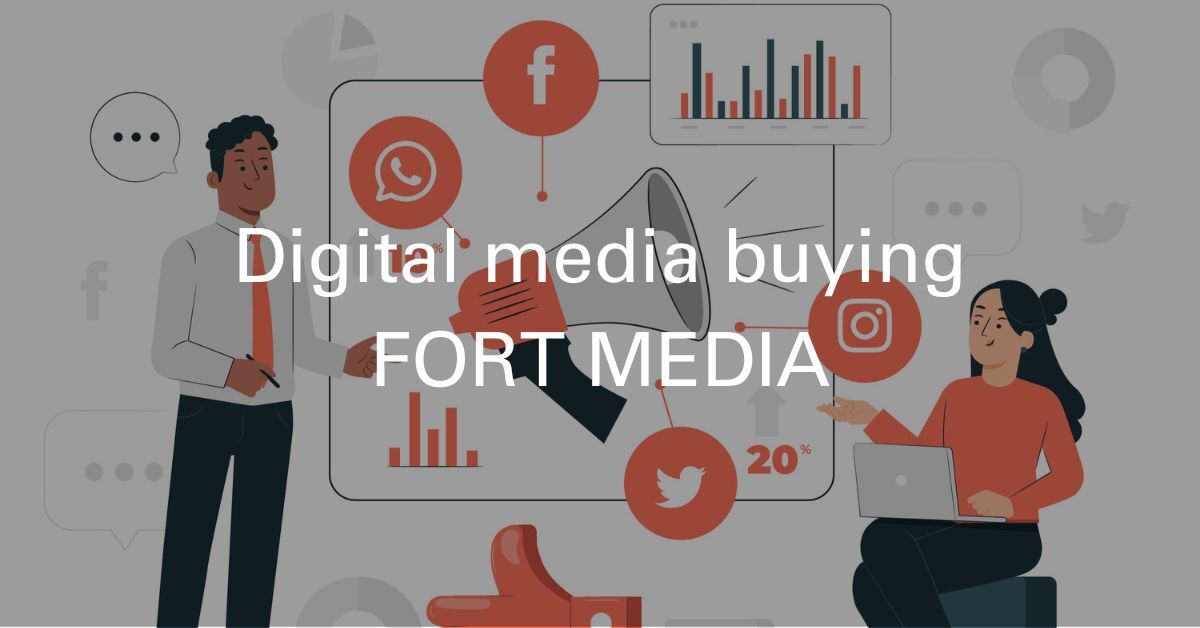Digital media buying has become essential to any marketing strategy in 2023. With more consumers spending time online and on mobile devices, brands must find ways to reach target audiences through digital channels effectively. With this article we will be providing an overview of digital media buying, including crucial terminology, benefits, how it works, and best practices for developing an effective digital media buying strategy.
What makes us expert in media buying? Simply because Fort Media has become google partner.
What is Digital Media Buying?
Digital media buying refers to purchasing advertising space on websites, mobile apps, social media platforms, and other digital channels. It involves collaborating with publishers, ad networks, and media companies to secure ideal ad placements that reach a brand’s target audience. The primary goal is to deliver the right messaging to the right individuals at the optimal moment.
Some key terminology in digital media buying includes:
- Programmatic advertising: Automated buying and selling of digital ads using an auction-based system.
- RTB (real-time bidding): A programmatic buying approach where advertisers bid on ad impressions as they become available.
- DSP (demand-side platform): A technology platform used by media buyers to purchase digital ads across multiple sources.
- Ad exchanges: Digital marketplaces enabling the buying and selling of online ad inventory via auctions.
Benefits of Digital Media Buying
Incorporating digital media buying into the marketing mix provides numerous advantages:
- Precise targeting: Digital allows advanced targeting by demographics, interests, behaviors, and more to reach specific audiences.
- Measurability: Detailed performance metrics enable ongoing optimization by identifying best performing placements and audiences.
- Cost efficiency: It enables extensive reach at lower costs and less waste versus traditional media.
- Flexibility: Campaigns can be adjusted in real-time based on data for improved results. Inventory and pricing also shift rapidly.
- Automation: Programmatic buying and RTB enable automation for more efficient campaigns.
How Digital Media Buying Works

The digital media buying process commonly involves these key steps:
Research and Planning
Extensive research is done to understand target audiences, brand objectives, and optimal media mix. Media buyers analyze customer data and past campaign performance to inform planning. Popular digital channels include social ads, search ads, display ads, native ads, online video, and more. Budget allocation across channels is determined.
Inventory Analysis
Media buyers research available ad inventory, pricing, and audience data across intended digital platforms, often leveraging third-party data and tools. Trends are identified to optimize ad placements for relevance, visibility, and cost efficiency.
Negotiation and Purchasing
Ad inventory is negotiated and purchased via programmatic buying, direct publisher sales, ad networks, or a combination. Contract terms like pricing models, formats, targeting capabilities, performance guarantees, and more are agreed upon.
Ad Creation and Distribution
Creative teams or agencies typically develop ad content like images, videos, copy, etc. Ads are distributed through an ad server to the purchased digital channels.
Campaign Monitoring and Optimization
Media buyers closely track campaign analytics using performance data and metrics like clicks, conversions, viewability, and engagement. Top-performing platforms, placements, audiences, and creatives are identified. Underperforming elements are removed or refined and new opportunities continually tested.
Best Practices for Digital Media Buying
Follow these proven best practices for optimal digital media buying strategy development and management:
- Set specific, measurable campaign goals and KPIs aligned to overarching business objectives. Track metrics like reach, clicks, conversions, viewability, engagement rate, ROI, etc.
- Leverage audience, contextual, geographic, daypart, and device targeting for highly refined audience targeting. Lookalike modeling can help expand reach.
- Test different bidding approaches across platforms, including open auctions, private marketplaces, and programmatic guaranteed deals. Assess cost, visibility, transparency, inventory quality.
- Employ A/B testing of different creatives, placements, audiences, and variables to determine the optimal combination.
- Frequently analyze performance, optimizing towards placements, platforms, ad types, etc. driving top results. Pause or eliminate underperforming elements.
- Monitor campaign pacing and delivery to ensure advertising budget is spent appropriately and reaches the target audience.
- Partner with an ad verification provider to monitor viewability, prevent fraud, and ensure brand safety.
Tips for Developing an Effective Digital Media Buying Strategy
Follow these tips when developing a comprehensive digital media buying strategy:
- Conduct in-depth target audience research through surveys, interviews, and data analysis to understand their demographics, interests, behaviors, pain points, and shopping habits.
- Determine clear campaign goals and success metrics based on broader business objectives like brand awareness, engagement, conversions, etc. Identify quantifiable KPIs.
- Map out the full consumer journey to identify the most strategic digital touchpoints and opportunities to reach audiences.
- Research trends and keep up with the latest digital platforms, ad formats, targeting capabilities, and measurement tools.
- Outline campaign flight dates, milestones, and timelines across channels to plan activity and measure impact over time.
- Build a test-and-learn approach into the media buying strategy to enable ongoing optimization and innovation as the landscape evolves.
- Allocate budget across channels and campaigns based on success metrics, audience research, past performance, and campaign objectives.
Conclusion
Digital media buying is crucial for brands seeking to engage today’s predominantly online, mobile-first consumers. By taking a data-driven, audience-centric approach, and constantly optimizing campaigns based on performance, brands can develop highly effective and efficient strategies. The result is strategically reaching the right customers with the right messaging via the right channels to drive awareness, consideration, and sales.


Digital Media Planning and Buying: A Basic Guide - Fort Media
November 20, 2023[…] Media planning and media buying are crucial parts of any marketing or advertising campaign. With the right media strategy and tactics, brands can effectively reach their target audiences and achieve their communications goals. This comprehensive guide covers everything you need to know about successful media planning and buying. You can follow our previous blog if you are interested only in Digital Media Buying. […]
Media Buying - Google Ads - Fort Media
November 25, 2023[…] This blog is a part of a series on “Digital Media Buying”. To read from the beginning, you can click here. […]
How to Create Creatives that Work in Media Buying - Fort Media
December 2, 2023[…] Those are the keys for creatives in media buying that truly work. Now it’s your turn. Follow this game plan for concepts and executions that compel audiences while converting your next campaign goals into reality. To read about Media Buying, Click Here. […]
Cheap video editing service - Fort Media
December 12, 2023[…] Please read our series of “”Media Buying” from here. […]